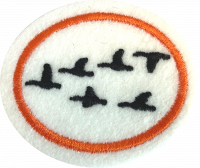Difference between revisions of "AY Honors/Migration/Requirements"
Jomegat bot (talk | contribs) (Bot: Automated import of articles *** existing text overwritten ***) |
|||
| Line 86: | Line 86: | ||
<noinclude></translate></noinclude><section end=req11h /></b> | <noinclude></translate></noinclude><section end=req11h /></b> | ||
| + | <section begin=challenge /> | ||
<b>12. <section begin=req12 /><noinclude><translate></noinclude>Do two of the following: | <b>12. <section begin=req12 /><noinclude><translate></noinclude>Do two of the following: | ||
<noinclude></translate></noinclude><section end=req12 /></b> | <noinclude></translate></noinclude><section end=req12 /></b> | ||
| Line 106: | Line 107: | ||
:<b>f. <section begin=req12f /><noinclude><translate></noinclude>Visit a common resting spot of migrating animals and identify as many different species as possible. | :<b>f. <section begin=req12f /><noinclude><translate></noinclude>Visit a common resting spot of migrating animals and identify as many different species as possible. | ||
<noinclude></translate></noinclude><section end=req12f /></b> | <noinclude></translate></noinclude><section end=req12f /></b> | ||
| + | <section end=challenge /> | ||
<section end="Body" /> | <section end="Body" /> | ||
| − | |||
Revision as of 02:27, 8 April 2021
1. What is migration? Give a short history of how humanity’s understanding of animal migration has grown.
2. Why do animals migrate?
3. What are some ways that animals know when and where to go?
4. What species of animals migrate? List two examples of each of the following:
- a. Birds
- b. Fish
- c. Mammals
- d. Insects
- e. Amphibians
- f. Reptiles
- g. Crustaceans
5. What are some dangers that migrating animals experience? Explain how the species of animals named above might encounter dangers in their migrations.
6. State the difference between a complete, partial, and nomadic migration and identify species that practice each type.
7. Describe at least three ways that humans can affect or disrupt animal migration patterns. What can be done to help solve these problems?
8. Choose either the Arctic Tern, Caribou, Salmon, Monarch Butterfly, Great Migration, or other significant migration and collect the following information:
- a. Common name and scientific name
- b. Migration route (draw a diagram of the route taken and the estimated number in the migration)
- c. Migration distance
- d. Reasons for migration
Creatively present what you have discovered.
9. How are migrating animals studied today? Give examples of three ways migrating animals can be tracked.
10. How are human migrations similar to animal migrations and how are they different?
11. Choose two Bible stories that mention a migration and discuss the purpose of the migration with your instructor.
- a. Noah
- b. Moses and the Exodus
- c. Abraham
- d. Joseph
- e. Babylonian capture
- f. Joseph & Mary as they fled to Egypt
- g. Acts 8 Christian dispersion
- h. Another of your choosing
12. Do two of the following:
- a. Participate in a conservation project that would make a positive impact for migratory animals.
- b. Talk to your group, write about, or create a video describing your experience on the conservation project completed in option a. Be sure to include information about the animals your efforts will affect.
- c. Watch a video about migration and share what you learned with your instructor.
- d. Visit a zoo, animal park, or aquarium where there are migratory animals on display. Learn three things about one of the migratory animals you observed.
- e. Take photographs of at least five migratory animals in the wild or captivity and share with your group.
- f. Visit a common resting spot of migrating animals and identify as many different species as possible.


